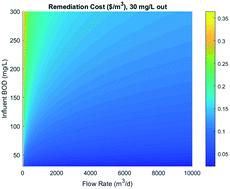Assessing the economic viability of wetland remediation of wastewater, and the potential for parallel biomass valorisation†
Abstract
Constructed wetlands have been shown to consistently remove a wide range of pollutants from contaminated water. However, no wide-ranging studies exist on the economic viability of this technology. This paper performs a high-level economic comparison between wetland remediation and conventional water remediation technologies, for a wide range of contaminant inputs, outputs, and flow rates. The cases considered are nutrient removal from wastewater, and remediation of low-pH and circumneutral acid mine drainage (AMD). The first-order P-k-C* model is used for nutrient removal, while a zeroth-order model is used for AMD remediation, with removal rate data taken from the literature. The number of wetland cells employed was found to significantly affect the overall cost of nutrient removal, allowing savings of up to 86% and 42% for biochemical oxygen demand and phosphorus removal, particularly for low concentrations and flow rates. For integrated secondary and tertiary treatment, wetland remediation was economically competitive down to stringent effluent standards. A sensitivity analysis was performed on sizing and costing parameters of nutrient removal wetlands, with required wetland size found to be most strongly correlated with the assumed removal rate, and land costs found to have relatively little effect on overall costs. Wetland remediation of AMD was only found to be economically favourable for less severe conditions and lower flow rates when treating low-pH drainage, and was heavily influenced by the acidity removal rate. However, the majority of site data from literature was found to fall within this range of conditions. For circumneutral AMD, wetland remediation was found to be cheaper for all simulated cases. The feasibility of offsetting wetland remediation costs through biomass valorisation was investigated for a range of products, with area requirements for minimum economic production identified as the principal barrier.



 Please wait while we load your content...
Please wait while we load your content...